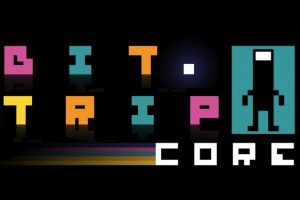577th played so far
Genre: Action/Music
Platform: Wii
Year of Release: 2009
Developer: Gaijin Games
The Bit. Trip series of games is – as far as I know, a set of small games that rely on rhythm game mechanics inside a bunch of other game genres. Bit. Trip Core is the second in the series, after Pong-based game Bit. Trip Beat and before endless runners, shooters and more. They share the rhythm mechanics, as well as the retro aesthetics. For this, we get closer to standard rhythm games.
Our Thoughts
The basics of this game resemble most other ‘standard’ music/rhythm games: squares fly to a line and you have to press the appropriate button at the right time. The difference here is that instead of it being one dimensional – often a straight line leading to the action point – it’s two dimensional here. The hit areas are laid out like a cross, similar to a d-pad (up, down, left, right), and obviously each direction corresponds to one on the controller.
It mostly means that you’re paying attention to more of the screen, as you have to see when each hit comes in, what the order is (especially when there are different speeds of the blocks) and they play around with blocks moving back and forth. It’s never playedd unfairly – they don’t change direction on you – but they require very quick reaction times. It’s incredibly difficult to keep up with, but the game has plenty of forgivement mechanics build in. Do well enough for long enough and the mistakes will be forgotten. Do badly and first you go to the ‘Nether’, which is a black and white stripped down version of the game. You lose the cool visuals and music, but let’s you focus. On the other hand, if you do really well you get rewarded with more sound and visuals – which are also just as distracting. And all of this flows naturally, which makes it feel even better.
As said, the aesthetics are ‘retro’ – in that they’re mostly blocky, Amiga style (Adventure as we played it is actually a pretty good reference). It’s more refined than that – the background are a lot more detailed and colourful, assuming you do well enough, and of course the music sounds better than what you could do in those days, but your UI and gameplay elements follow that trend. That simplicity aids it, focusing the gameplay and allowing everything to flow out of that instead.
Final Thoughts
This game plays really well. It intentionally looks the way it looks – it wouldn’t win prices for it, but it works for the gameplay. It plays really well, though, slowly increasing the challenge (and teaching you different block types along the way, giving you some time to get used to it before throwing it into the more hectic mix). In fact, one downside is that there is no explanation at all, making starting the game more difficult than it should be, but after that it really does work out well and you want to see what more is coming.
